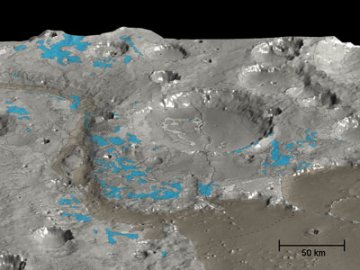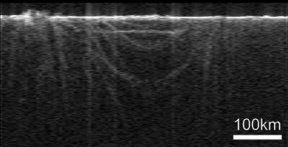Evidence of a Wet Mars
An orbiter provides new details about when and where liquid water existed on Mars.
By Emily Sohn
The news from Mars is dripping with interesting clues about the planet’s wet history.
Mars nowadays has no large pools of liquid water on its surface, but evidence gathered over 30 years suggests that the planet used to have lots of flowing water. Now, the European Space Agency’s Mars Express orbiting spacecraft has gathered information that suggests where and how long ago Mars’ water flowed.
 |
|
In this infrared view of the ancient Martian canyon Marwth Vallis, an instrument called a spectrometer has mapped water-rich minerals (blue). These minerals track the long-ago era when liquid water flowed through the region.
|
| ESA/OMEGA/HRSC |
The Mars Express orbiter carries a piece of equipment called a spectrometer, which analyzes the planet’s surface. Over the last 18 months, the spectrometer has revealed two classes of surface minerals that were formed by water. The minerals cover large areas of Mars in multiple places.
One type of mineral, which forms when molten rock spends a long time in contact with water, appears only on the oldest of Mars’ landscapes. These areas date back to about 3.8 billion years ago.
The other class of minerals appears only on younger terrain. Called hydrated sulfates, these minerals need just a brief dousing with water to form. They also require acidic conditions.
The evidence suggests that Mars has gone through at least two major climate phases over the years, astronomers say. Early on, the planet was very wet. Later, the environment changed, becoming acidic.
Since June, Mars Express has also been collecting data with a radar sounder. This tool sends out radar waves and reads the echoes that come back. It ends up with information about what’s below the planet’s surface.
So far, the radar sounder has revealed that 98 percent of a 3-kilometer-thick (1.9-mile-thick) ring of ice at Mars’ north pole is made of frozen water. Despite the weight of the ice, however, the layer underneath it (called the lithosphere) has, surprisingly, not sunk. This might be because the lithosphere is thick enough to support the ice.
 |
|
This radar image shows the echo of a buried crater, which may be filled with ice, beneath Mars’ northern lowlands.
|
| ASI/NASA/ESA/Univ. of Rome/JPL |
In another area, the radar sounder also revealed what seems to be an ice-filled crater buried underneath the surface in Mars’ northern lowlands. The crater is big—about 250 kilometers (155 miles) wide and 1.5 to 2.5 kilometers (1 to 1.5 miles) deep. Several channels meet there.
Scientists have long wondered what happened to all the water on the Red Planet. Buried, ice-filled craters might be part of the answer.—E. Sohn
Going Deeper:
Cowen, Ron. 2005. Red Planet express: Mars spacecraft traces a watery tale. Science News 168(Dec. 10):372-373. Available at http://www.sciencenews.org/articles/20051210/fob4.asp .
You can learn more about the Mars Express mission and its findings at www.esa.int/SPECIALS/Mars_Express/index.html and www.esa.int/SPECIALS/Results_from
_Mars_Express_and_Huygens/ (European Space Agency).
Sohn, Emily. 2004. Rover makes splash on Mars. Science News for Kids (March 10). Available at http://www.sciencenewsforkids.org/articles/20040310/Note2.asp .
______. 2003. Melting snow on Mars. Science News for Kids (Feb. 26). Available at http://www.sciencenewsforkids.org/articles/20030226/Note3.asp .







